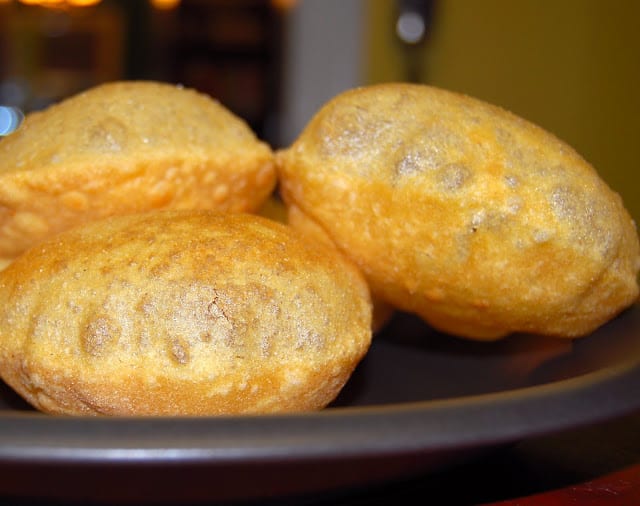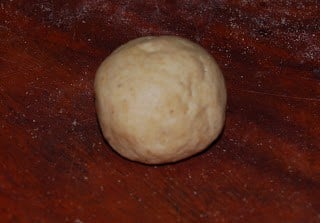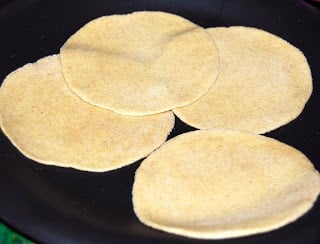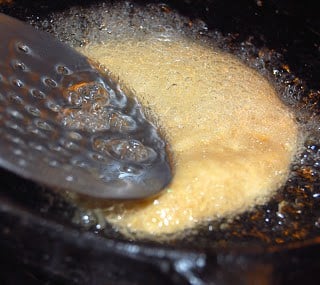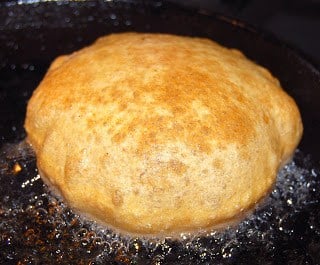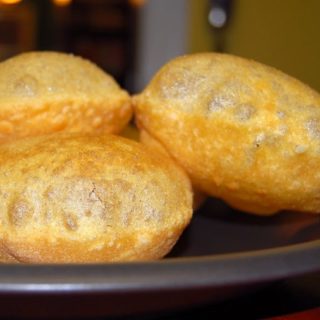No feast for any occasion in any part of India would be complete without a poori or puri. This puffy, deep-fried bread, with its pert, rotund looks and unparalleled delicousness, is deeply beloved by kids and adults. When it makes an occasional appearance at lunch in our home it puts smiles on both Desi’s and Jay’s faces. Pooris are super simple to make. The basic dough is similar to that you’d make for a homemade roti, although pooris are rolled out much smaller. There are just four ingredients in the dough–flour, water, oil and salt–and you will need vegetable oil to deep fry them. Almost anyone can make a decent poori, but to make a perfect poori that’s crisp yet soft, and that puffs up into a perfect round in the hot oil, you need some skill. Practice will definitely help and the more pooris you make, the better you’ll get at it. I’m going to make the process easier for you by sharing the tips and tricks I’ve learned over years of making this bread, and I’m going to share them with you today. It should help give you a leg up, for sure, and you will soon be turning out perfect pooris faster than you think.
What you’ll love about this poori recipe
Although they are deep-fried, and I get that you have sworn yourself off “unhealthy” foods, you’d have to be a true damp squib to turn your nose up at a poori. For one, it’s absolutely delicious, the perfect bread to scoop up chana masala or any spicy curry with. It’s not that unhealthy. It’s made with whole wheat flour. It’s crispy and soft, all at the same time. It’s easy enough to make.
Ingredients
Whole wheat flour. If you have access to atta, a whole wheat flour sold at Indian stores and online, use it because it works best here. Atta is more finely ground that regular whole wheat sold in U.S. stores and I’ve seen it in the international foods aisle at Whole Foods, although your local Indian grocer is probably a better bet for price. You will get the best pooris with atta, but if you can’t find it, just use whole wheat flour. Vegetable oil: You need just a tiny bit to make the dough, but you will need more for deep frying. A flavorless oil that has a high smoke point, like peanut oil, sunflower oil, safflower oil, avocado oil or canola oil works best to deep-fry foods like pooris. I usually cook with avocado oil but I keep peanut oil or sunflower oil on hand for deep frying. Salt, no more than half a teaspoon. Water, for kneading.
Tips and tricks for the perfect puri
The first step is to make your dough, and all you need to do is mix the flour with the oil and salt and then knead it with just enough water. To ensure you will get perfect pooris, you need to get the consistency of your dough right. For pooris you want a stiff dough with no stickiness. You are less likely to make a mistake and overmoisten your dough if you knead by hand. Trickle the water in a tiny bit at a time. If you do make your dough in the food processor or stand mixer–and you totally can–make sure you drizzle water in very, very slowly so you don’t accidentally overmoisten. Once you have your stiff dough, place it in an airtight container and set it aside to rest for half an hour. Now comes the really important part: rolling the pooris. This step will decide whether or not your pooris puff up in the oil and become perfectly round. An unevenly rolled poori won’t puff up. To get perfect, evenly rolled pooris, don’t use the heave rolling pins with ball bearings that you’d use to roll out pie or puff pastry–use a French rolling pin, which is slimmer and is much easier to make small breads, like pooris, with. Indian rolling pins are very much like the French pins and you can find them at an Indian grocery store or online. My final tip is to ensure you have your oil at the perfect temperature. It’s really worth investing in a frying thermometer or candy thermometer and to ensure that you keep the oil between 360 and 375 degrees at all times when you’re frying the puris. This ensures that the food takes in very little oil, and reduces the guilt that comes with eating deep-fried foods. Fry a single poori at a time. Push the poori down into the oil, gently, with a spider or spatula, until it begins to puff up. Wait until it’s perfectly round before you flip it. If it doesn’t puff up (don’t worry, you will get better with practice, flip it once it turns golden on the underside). Fry the other side for about 20-30 seconds more. For crispy pooris, let them go longer in the oil. Always place the freshly-fried pooris on a baking sheet lined with paper towels to let any excess oil clinging to the pooris drip off. Always eat the pooris right after you make them. The air in the poori will dissipate the longer it stands, and it will deflate. It will taste delicious still but a hot poori is a gastronomic experience to be cherished. To make pooris crisper you can also use a mix of whole wheat and all purpose flour.
What to serve pooris with
Chana masala (or serve it with the chickpea curry in this Chana Bhatura recipe) A spicy curry like this vegan keema masala or this Instant Pot Vegan Butter Chicken. A dry potato curry like potato masala. This is how we eat pooris in Maharashtra, the state where I was born.
Recipe card
Check to get new recipe updates by email.
